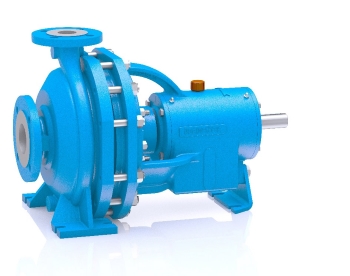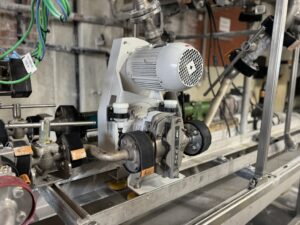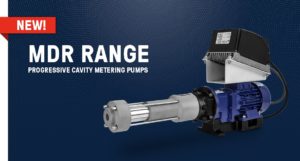Rheinhütte Pumpen supplies pumps for new process of Aurubis AG: Production of Sulphuric Acid Through Heat Extraction

Manufactured with acid‐resistant ferritic cast steel, the RN‐B is employed to pump highly concentrated sulphuric acid. (Image: Rheinhütte Pumpen)
The Elbphilharmonie concert hall was not solely responsible for highlighting the HafenCity Hamburg project. In Europe s largest urban development project, the Hanseatic City of Hamburg plans to regenerate a site of 157 hectares up until 2029 to create an urban living and working environment for around 14,000 residents and 45,000 workers1.
One immediate neighbour of the HafenCity at least is an internationally renowned name in expert circles and making an unusual contribution to the ecological concept underlying the HafenCity. Aurubis AG is a global leader among suppliers of non-ferrous metals and the world s largest copper recycler. The enterprise processes complex metal concentrates, scrap metals and recycling materials containing metal to produce metals of the highest quality.²
While industrial firms are not necessarily regarded as the most desirable of neighbours in residential areas, Aurubis offers (future) residents and workers in the HafenCity an extremely valuable advantage. The company converts sulphur dioxide (a by-product of copper refining) into sulphuric acid in a contact plant through an exothermic process. The heat created as a result of this is practically CO2-free and is mainly used to supply district heating to the eastern district of the HafenCity. According to the objective set for 2029, exploitation of industrial heat will save approximately 4,500 t of CO2 per annum in the completed development.³
Taken together with internal usage at Aurubis and further external use, up to 20,000 t of CO2 will be saved each year.
Sulphuric acid production needs to be realised at a higher temperature than previously to enable the extraction of heat, and part of the contact plant has been converted specifically to achieve this. Hot sulphuric acid is conveyed here through sulphuric acid pumps supplied by ITT Rheinhütte Pumpen GmbH from Wiesbaden. The company is a globally renowned pump specialist whose products play a leading role in international competition, particularly due to the comprehensive variety of materials and design features they incorporate.
Decisively important: The choice of material
Highly concentrated sulphuric acid (> 90% H2SO4) does not, in the first instance, place any particular demands on the materials used. Conventional chromium nickel stainless steels create a solid passivated layer on the surface that provides protection against further corrosion. However, this passivated layer is subject to attack and removal as a result of the impact of temperature and flow erosion. A loss of material - or, in other words, corrosion - occurs if the removal rate exceeds the formation of a new layer.
A special material therefore needs to be used here for conveying highly concentrated sulphuric acid at temperatures of up to 125°C. To address this need and other applications, Rheinhütte has added standard RN series chemical pumps made of special acid-resistant ferritic cast steel (1.4136S) to its range. Due to its high chromium content in the alloy (around 30% Cr), this material forms a stable, hard protective chromium oxide layer which reliably prevents corrosion of wet surfaces at temperatures of up to 140°C.
Moreover, high silicon-alloyed cast materials are also suitable for the conveyance of sulphuric acid. A high silicon content in the structure creates a passivated silica layer here that protects the pump material against corrosion. However, experts at Rheinhütte opted in this case to adopt the alloy with a high chromium content for economic reasons.
Sealing: Traditional, but extremely reliable
The sealing system employed for the rotating pump shaft is a particularly important issue when it comes to working with corrosive media. Mechanical seals and magnetic couplings represent the technological state of the art, and these are employed in Rheinhütte sulphuric acid pumps in a variety of versions, depending on the application involved.
Following consultation with and on the recommendation of Rheinhütte, those responsible at Aurubis AG have opted for a traditional, but extremely reliable sealing system: a hydrodynamic shaft seal. Through contact-free operation and an absence of wear parts, this solution requires no maintenance and is particularly suitable for continuous operation (as occurs in the sulphuric acid plant). With the aid of impeller back blades and the downstream auxiliary impeller, the shaft bushing is completely relieved in hydrodynamic terms of pump and inflow pressure. The medium is kept away from the shaft passage, and the pump remains sealed and drip free during operation without peripheral systems and free of any wear.
Rheinhütte already unveiled this technology as early as 1925 at ACHEMA in Frankfurt, and it is still a classic solution employed for pumping hot sulphuric acid today.
Efficiency: Decisive for lifecycle costs
Energy costs are the greatest cost factor when the lifecycle of a pump is appraised as a whole. This applies in particular to pumps which are in continuous operation. Smaller efficiency advantages can also achieve considerable energy savings in the long term, and the RN pump series demonstrates its superiority over other makes in this respect. In particular, in a project that aims to achieve as climate-neutral a supply of heat as possible and, consequently, reduce CO2 emissions, efficiency is an important factor when selecting pumps.
1 https://www.hafencity.com/upload/files/files/HafenCityProjekte_Maerz_2017_deutsch.pdf
² https://www.aurubis.com/de/public‐relations/pressemitteilungen‐‐news/news/2018/13.04.2018‐das‐herz‐derfernwarme‐fur‐die‐ostliche‐hafencity‐sitzt‐jetzt‐am‐rechten‐fleck
³ https://www.aurubis.com/de/public‐relations/pressemitteilungen‐‐news/news/2017/17.02.2017‐‐‐aurubis‐undenercity‐schliessen‐vertrag‐uber‐die‐lieferung‐von‐co2‐freier‐abwarme‐fur‐die‐ostliche‐hafencity
Source: ITT Rheinhütte Pumpen GmbH







